Islamabad, Oct 1: Islamabad Water Crisis Hits Critical Point, particularly in Quetta and Islamabad, raising serious concerns about public health and urban sustainability. In Quetta, the water table has dropped 300 feet in the last decade, falling nearly 30 feet annually.
The city faces the risk of becoming uninhabitable, with officials even considering relocating the capital. Meanwhile, Islamabad is grappling with severe water contamination, including the rise of “blue-baby syndrome” caused by nitrate pollution.
Quetta, along with four other cities classified as “dark zones,” is experiencing critically low groundwater levels, with some areas reporting depths of over 1,200 feet.
The Ministry of Water Resources warns that Balochistan could face a complete water collapse within a few years if immediate measures aren’t taken.
Despite federal efforts like installing solar-powered tube wells, experts argue that no engineering solution alone will solve the crisis; instead, stopping groundwater extraction is essential.
In Islamabad, the contamination of drinking water by harmful pollutants, including nitrates and coliform bacteria, poses a public health risk, particularly for infants. The city’s water supply is insufficient, receiving only 80 million gallons per day against a demand of 129 MGD.
The Senate Standing Committee on Water Resources and the Pakistan Council of Research in Water Resources (PCRWR) have expressed concern over the deteriorating water quality and declining groundwater levels, which have dropped significantly since the 1960s.
Both cities face an urgent need for stronger water management regulations, with officials calling for revised legislation and stricter enforcement to address the growing crisis.
